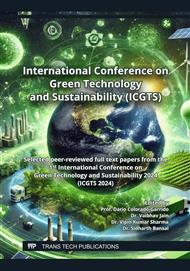p.3
p.15
p.21
p.29
p.47
p.53
p.67
p.79
p.89
Study on the Tribological and Physiochemical Properties of Algae Oil as a Sustainable Green Lubricant
Abstract:
Lubricants are substances that minimize wear and friction for optimal performance and lower the likelihood of malfunctions. Over 95% of lubricants used today are made of non-renewable petroleum, which is being depleted and emitting emissions that are bad for the environment and people's health. The greatest substitutes are biolubricants, whose primary sources include edible and inedible oils that are generated from lipids and carbohydrates found in various animals, plants, and microbe sources, with the exception of Algae. An eco-friendly and sustainable resource for green lubricants, microalgae oil is vital to the lubricant business. Microalgae are photoautotrophs, meaning they grow quickly and can be grown multiple times a year with less energy needed. Because microalgae do not require agricultural land or climatic conditions to develop, they may also be produced in wastewater and saltwater. As a result, their production costs are also lower. Microalgae has exceptional chemical compositions, including significant levels of lipids, hydrocarbons, polysaccharides, and gelling properties. Microalgae are suitable for lubrication because they contain high amounts of saturated, mono-unsaturated, and polyunsaturated fatty acids, which give algae their good tribological, physiochemical, and rheological qualities and minimize friction. Molecular weight, viscosity, oxidation stability, thickening behaviors, friction coefficient, antiwear, antiseizure, thermal stability & characteristics, crystallinity, and rheology of polysaccharides as sustainable green lubricant are all covered in this review study about the lubricating properties of microalgae oil.
Info:
Periodical:
Pages:
47-51
Citation:
Online since:
August 2025
Authors:
Keywords:
Price:
Сopyright:
© 2025 Trans Tech Publications Ltd. All Rights Reserved
Share:
Citation:


